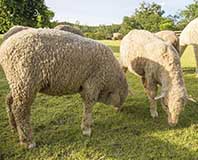Read the latest information on
Foot-and-mouth disease
 It’s all too tempting to dismiss the National Sheep Health Declaration (SHD) as more unnecessary paperwork, but it is a vital tool for producers who want to manage the risks of endemic diseases.
It’s all too tempting to dismiss the National Sheep Health Declaration (SHD) as more unnecessary paperwork, but it is a vital tool for producers who want to manage the risks of endemic diseases.
The SHD, which is supplied during the sale or agistment of livestock, sets out what the vendor or owner knows about the health status of their stock.
For stud breeder and veterinary consultant, Dr Peter Dagg of Murrumbateman, NSW, the value of the SHD speaks for itself.
“The main benefit is being assured that the sheep you buy don’t have major diseases such as Johne’s disease, ovine brucellosis or footrot, and that they don’t have pests such as lice,” Dr Dagg said.
For those buying and selling sheep destined for the processors, Dr Dagg also explained that “you also understand if they [your new sheep] have been recently drenched and if they’re under a withholding period.”
Many common endemic disease conditions can be a thorn in your side for months or years, and are extremely costly in terms of control measures and lost production. Always requesting an SHD with any stock purchase can help to ensure your flock remains as healthy as possible.
This kind of proactive biosecurity measure saves you time on-farm, boosts health, welfare and productivity, and reduces losses and waste through the value chain.
As with any farm input, due diligence allows you to make an informed choice as to how you manage the risks that potentially come with a new consignment of sheep.
According to Dr Dagg, filling in the SHD is a quick, easy job.
“Using SHDs is simple. You can either pre-fill them online, by ticking a few boxes and filling in a few fields, or print them off and fill them out by hand when you’re at the yards.”
Sheep producers wanting to know more about on-farm biosecurity can visit the sheep industry page on the Farm Biosecurity website, which includes a download link for SHDs.